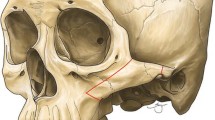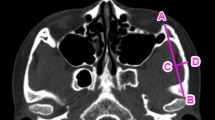Abstract
Oriental people usually have a wide midface and a prominent malar curve. The zygomatic bone forms the prominence of the cheek, and it is the most important part in determining the ideal oval shape of the face on the frontal view and the character of the oblique profile. Therefore, zygoma contouring is commonly performed. Women with a prominent zygoma have an inferiority complex associated with unattractive facial features resembling aged, melancholic, and strong characters in oriental culture. Zygoma is the highlighted area of the midface and a major determinant of midfacial shape, but harmony with the adjacent area is very important. Therefore, to obtain the optimal outcome of reduction malarplasty, various ancillary procedures must be performed simultaneously. The authors performed 30 reduction malarplasties during the past 2 years. The amount of bone to be removed was determined by the preoperative interview, physical examination, and x-rays. Intraoral incisions provided access to the zygomatic body and lateral orbital rim. After the L-shaped osteotomy, two parallel vertical and transverse osteotomies in the medial part of the zygomatic body, the midsegment was removed. The posterior portion of the zygomatic arch was approached through a stab incision in the preauricular area. A 3-mm osteotome was used. After completion of the osteotomy, the movable zygomatic complex was reduced medially and superiorly, then fixed with miniplates and screws on the zygmaticomaxillary buttress. The combined operations with reduction malarplasty were as follows: reduction of the mandibular angle in 15 cases, rhinoplasty in 14 cases, and double-fold operation in 11 cases. The follow-up period was 2 months to 2 years, and all the patients were satisfied with the results. In conclusion, this method is a very simple, easy, and safe method that reduces the operating time to 1 h and minimizes postoperative edema and swelling. Consequently, recovery time is relatively short, and no conspicuous scars in the preauricular area are left. The authors also performed many ancillary procedures, thereby obtaining optimal satisfaction with their results, including decreased facial width and superior mobilization of the prominent area. They were able to prevent postoperative cheek drooping, and to give the patients a more youthful, charming look.




Similar content being viewed by others
References
Baek SM, Chung YD, Kim SS: Reduction malarplasty. Plast Reconstr Surg 88:53, 1991
Caronni EP. Craniofacial surgery. 1st ed. Little, Brown and Company, p 523, 1985
Hahm JW, Baek RM, Oh KS, Baek SM: 10-year experance on reduction malarplasty. J Korean Soe Plast Reconstr Surg 24:1478, 1997
Hiuderer UT: Malar implants for improvement of the facial appearance. Plast Reconstr Surg 56:157, 1975
Hwang YJ, Jeon JY, Lee MS: A simple method of reduction malarplasty. Plast Reconstr Surg 99:348, 1997
Koh SH, Chung YK, Park BY, Lee YH: Malarplasty using the tripod osteotomy through the intraoral approach. J Korean Soe Plast Reconstr Surg 17:240, 1990
Onizuka T, Watanabe K, Takasu K, Keyama A: Reduction malar plasty. Aesth Plast Surg 7:121, 1983
Paul NM: Facial injury. In: McCarthy JG (ed) Plastic surgery. Saunders Co.: philadelphia p. 990, 1990
Powell NB, Riley RW, Laub DR: A new approach to evaluation and surgery of the malar complex. Ann Plast Surg 20:206, 1998
Sumiya N, Kondo S, Ito Y, Ozumi K, Otani K, Wako M: Reduction malarplasty. Plast Reconstr Surg 100:461, 1997
Yang DB, Park CG: Infracture technique for the zygomatic body and arch reduction. Aesth Plast Surg 16:355, 1992
Author information
Authors and Affiliations
Corresponding author
Rights and permissions
About this article
Cite this article
Lee, KC., Ha, SU., Park, JM. et al. Reduction Malarplasty by 3-mm Percutaneous Osteotomy. Aesth Plast Surg 30, 333–341 (2006). https://doi.org/10.1007/s00266-005-0055-7
Received:
Accepted:
Published:
Issue Date:
DOI: https://doi.org/10.1007/s00266-005-0055-7




